Next Gen Laura Mainz Taking control after a cancer diagnosis
Laura Mainz grew up in a tiny village in midwestern Germany, with just as many cows as people. But the sweeping landscape speckled with farms never swayed her toward plant biology—instead, her interest in the human body grew.
Once she entered high school, two paths presented themselves in the form of two internships: medicine and research. After spending time in a hospital and in a pharmaceutical company, Mainz decided on research and began planning her undergraduate studies in biology.
Newly enrolled at the Julius Maximilians University of Würzburg, Germany, Mainz took an immediate liking to cancer biology and, a bit later, the related process of cellular recycling, called autophagy.
“Looking back, I think my father being diagnosed with multiple myeloma, a very rare and non-curable bone marrow cancer, when I was in high school is what made me so interested in the topics of cancer and cell death,” recalls Mainz. “When we got the diagnosis, I felt so helpless and confused, I went on Wikipedia for information and remember seeing these dismal statistics—an average survival rate of five years. Studying cancer became my way of coping, of taking control of an otherwise out-of-control situation.”
Mainz’s father went on to exceed Wikipedia’s survival rate predictions, fighting for nine years rather than the predicted five. Meanwhile, Mainz continued to work toward understanding the fundamental drivers of cancer with the goal of preventing the disease altogether.
“I want fewer people to hear the words, ‘You have cancer.’ […] Instead of focusing on treatment after diagnosis, I would like to understand how to prevent cancer in the first place.”
–Laura Mainz
After earning her PhD, Mainz felt ready to go abroad to continue her research. Having followed the Salk Institute since her undergraduate days, she set her sights on the lab of Professor and CSO Jan Karlseder for her postdoctoral research.
Researchers in Karlseder’s lab focus on understanding telomeres, the protective endcaps on DNA strands that shorten as we age and, in turn, initiate a cascade of signals that control cell behaviors like preventing healthy cells from becoming cancerous. In these aging cells, Mainz looks at a process called replicative crisis, where the body promotes inflammation and widespread cell death (mediated by autophagy) to kill off aged or unstable cells and prevent them from becoming cancerous.
“My main question is whether cell death during replicative crisis is really the last barrier to prevent tumor formation,” says Mainz. “Perhaps there is another barrier between the transformation of a healthy cell to a cancer cell. That idea that we could prevent cancer from developing altogether—that’s what drives my research.”
To study replicative crisis, Mainz developed a sophisticated mouse model to pinpoint where, when, and how replicative crisis can go wrong and lead to the formation of cancerous cells. Her model has both shortened telomeres and an inability to perform autophagy, so Mainz can examine how long it takes tumors to arise and where in the body they typically appear.
“We want to find where in the body cancer is most likely to begin, and then find the exact last point those cells were healthy,” says Mainz. “If we know which cells are most at risk and at what point they become cancerous, we can then work to target those cells and prevent them from reaching that point.”
When not in the lab, Mainz volunteers in community outreach and advocacy for the Leukemia & Lymphoma Society, a nationwide nonprofit organization supporting blood cancer patients and their families by offering free resources and financial aid, as well as funding related research.
“Until I started at the Leukemia Lymphoma Society, I never expected myself to enjoy community outreach and advocacy,” says Mainz. “But I enjoy those face-to-face interactions so much that I can see myself pursuing a position in clinical trial research in the future.”
When she’s not busy in the lab or volunteering, Mainz tries to keep her mind off her science. She’ll take off on a long run, adventure with friends and family in the outdoors, or participate in one of the many dance genres she’s dabbled in since starting ballet at age seven—jazz, hip-hop, modern, salsa, bachata—the list goes on.
While it can be difficult to spend so much time thinking about a weighty topic like cancer, Mainz motivates herself by remembering the day of her father’s diagnosis.
“I want fewer people to hear the words, ‘You have cancer,’” says Mainz. “It wasn’t even my diagnosis, but hearing those words about a loved one sitting by your side—it has a huge impact on your life. Instead of focusing on treatment after diagnosis, I would like to understand how to prevent cancer in the first place.”
Support a legacy where cures begin.
Featured Stories
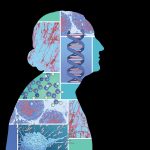 Interaction + Infrastructure = Innovations in Healthy AgingSalk formula recalculates aging research, shifting focus to overall resilience and health span.
Interaction + Infrastructure = Innovations in Healthy AgingSalk formula recalculates aging research, shifting focus to overall resilience and health span. Professor Jan Karlseder named Salk’s Chief Science OfficerOn February 1, Jan Karlseder started as Salk’s new senior vice president and chief science officer (CSO).
Professor Jan Karlseder named Salk’s Chief Science OfficerOn February 1, Jan Karlseder started as Salk’s new senior vice president and chief science officer (CSO).  Salk mourns the loss of Nobel Laureate Roger GuilleminThe Institute remembers the “father of neuroendocrinology” for his many contributions to science and friendship to all.
Salk mourns the loss of Nobel Laureate Roger GuilleminThe Institute remembers the “father of neuroendocrinology” for his many contributions to science and friendship to all.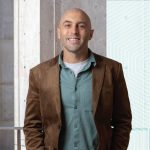 Daniel Hollern–Turning a cancer diagnosis into a career in basic researchAssistant Professor Daniel Hollern pivoted his career trajectory after a family member’s life-changing diagnosis pushed his already-curious mind off a cliff of questions—starting with, “What can I do to help him?”
Daniel Hollern–Turning a cancer diagnosis into a career in basic researchAssistant Professor Daniel Hollern pivoted his career trajectory after a family member’s life-changing diagnosis pushed his already-curious mind off a cliff of questions—starting with, “What can I do to help him?”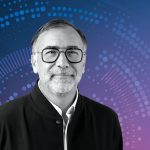 Jerry Sheehan–Collaborating shoulder to shoulder with scientistsWhen you think about a person who heads an information technology department, you might not envision them working shoulder to shoulder with research scientists. But that’s exactly the approach Jerry Sheehan is taking as Salk’s new chief information officer (CIO).
Jerry Sheehan–Collaborating shoulder to shoulder with scientistsWhen you think about a person who heads an information technology department, you might not envision them working shoulder to shoulder with research scientists. But that’s exactly the approach Jerry Sheehan is taking as Salk’s new chief information officer (CIO).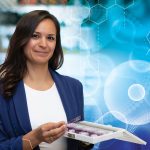 Laura Mainz–Taking control after a cancer diagnosisLaura Mainz grew up in a tiny village in midwestern Germany, with just as many cows as people. But the sweeping landscape speckled with farms never swayed her toward plant biology—instead, her interest in the human body grew.
Laura Mainz–Taking control after a cancer diagnosisLaura Mainz grew up in a tiny village in midwestern Germany, with just as many cows as people. But the sweeping landscape speckled with farms never swayed her toward plant biology—instead, her interest in the human body grew.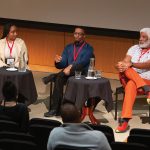 Black Association affinity group cultivates welcoming environmentThe Black Association at Salk (BAS) was one of the first affinity groups formed at Salk in 2020. Since that time, it has established itself as a welcoming space and go-to for resources for all Black Salk community members.
Black Association affinity group cultivates welcoming environmentThe Black Association at Salk (BAS) was one of the first affinity groups formed at Salk in 2020. Since that time, it has established itself as a welcoming space and go-to for resources for all Black Salk community members.



















































